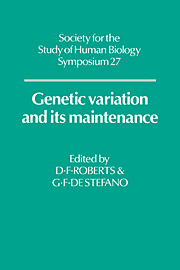Book contents
- Frontmatter
- Contents
- Preface
- Part I Genetic Diversity - Its Dimensions
- Genetic polymorphisms - a widening panorama
- Some implications of improved electrophoresis techniques for population genetics
- HLA variation in the tropics
- Chromosome polymorphism in humans
- Restriction fragment length polymorphisms in the human genome
- Nucleotide sequences, restriction maps, and human mitochondrial DNA diversity
- Mitochondrial DNA variation in eastern highlanders of Papua New Guinea
- The Contribution of polymorphisms in mtDNA to population genetic studies
- Part II Genetic Diversity - Its Origin and Maintenance
- GENETIC DIVERSITY - APPLICATIONS AND PROBLEMS OF COMPLEX CHARACTERS
- Index
The Contribution of polymorphisms in mtDNA to population genetic studies
Published online by Cambridge University Press: 05 March 2012
- Frontmatter
- Contents
- Preface
- Part I Genetic Diversity - Its Dimensions
- Genetic polymorphisms - a widening panorama
- Some implications of improved electrophoresis techniques for population genetics
- HLA variation in the tropics
- Chromosome polymorphism in humans
- Restriction fragment length polymorphisms in the human genome
- Nucleotide sequences, restriction maps, and human mitochondrial DNA diversity
- Mitochondrial DNA variation in eastern highlanders of Papua New Guinea
- The Contribution of polymorphisms in mtDNA to population genetic studies
- Part II Genetic Diversity - Its Origin and Maintenance
- GENETIC DIVERSITY - APPLICATIONS AND PROBLEMS OF COMPLEX CHARACTERS
- Index
Summary
INTRODUCTION
The advent of the powerful recombinant DNA techniques has given new perspectives on the origin and expansion of genetic diversity within the human species. Studies at the DNA level have yielded a host of new genetic markers and have thus greatly increased the number of human genetic differences that can be detected both among individuals as well as among populations. Genetic polymorphisms in the DNA itself can be identified either by direct sequencing of the DNA molecule - which is a laborious procedure requiring enormous effort - or by using restriction enzymes to cut the DNA at specific points and so to produce fragments whose lengths indicate whether or not the relevant base pair sequence is present in the DNA of the individual. Mitochondrial DNA which is a cytoplasmic gene system has in the last few years been very well characterized at the molecular level; possibly it is “the best known piece of human DNA” (Cann, 1982).
Most of the studies bearing on mtDNA variation in higher animals and humans have focused on evolutionary issues, emphasizing its uses as a marker of evolutionary phenomena (Brown, 1983); these included tracing patterns of common ancestry among species (Brown et al, 1982) and among human ethnic groups (Johnson et al, 1983), estimating times of divergence among major geographical groups of humans (Cann et al, 1982), and even attempting to unravel the evolutionary history of man and his relatives by comparisons of restriction maps of gorilla, orangutan, gibbon and chimpanzee (Ferris et al, 1981). But there are many more uses to which it can be put in understanding the biology of man.
- Type
- Chapter
- Information
- Genetic Variation and its Maintenance , pp. 101 - 110Publisher: Cambridge University PressPrint publication year: 1986
- 1
- Cited by

